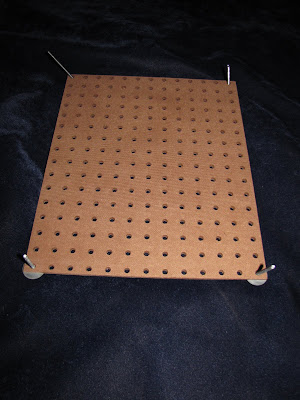
I started out by wielding a can of RustOleum Universal Hammered Spray Paint in Silver. It looked alright, though I wasn't omfg in love with it. So I stripped it with paint thinner (and killed off more than a few brain cells in the process. There goes algebra!) (Hah! as if I knew algebra in the first place!) and applied a new coat of Heirloom white. It looked pretty schnazzy, and I was happy with it.
Oh! I forgot to mention that the cord on the base was insanely old and one of the connectors was haphazardly attached, so I decided to rewire it. Simple task, to be sure. Except I kept blowing the breaker. Boo.
Next, I tackled the shade. I wanted something pretty and graphic, but didn't like the options I found online or in stores. I liked this one a lot, but I have a hard time spending $ on something I think I can do myself. So I went out to JC Penny and scored a big old drum shade at 40% off, and then went to Jo-Ann's to pick up some Jacquard Neopaque fabric paint in white, black, and deep red.
For the next forty hours or so (I *so* wish I was exaggerating), I hand painted the red blossom/black branch/white accent pattern on the shade. The paint was quite easy to work with, but I completely underestimated the total area of the shade that would need to be painted. So while the small/intricate pattern seemed easy peasy when I started, by the end it felt boring and tedious.
After the shade was finally finished, I attached it to base, and was pleased enough. I set it on the Frankenstein Table and moved onto the next project. A few weeks later, something fell behind Frankenstein, and rather than pull the ottomans out from underneath it to retrieve the item, I decided to pull the table over. As Frankenstein's are want to do, he lumbered forward and CRASH BAM BOOM, the legs collapsed and everything on top of it toppled off onto the floor. Pirate Lamp died, as did several small marble vases my mom had found for me. DAMN IT. AND I didn't even get a picture of the damned thing before it shattered.
So I spent several months trying to find a suitable replacement base for my magnificent lamp shade. I was determined the thrift it, because my mom and sister are such talented thrifters and certainly *I* would be able to do it! HAH.
As any sad and pathetic person might do, I was at Ikea on my birthday. I snagged a Jonsbo Barby lamp base in a pale pale pink. The only problem is that the base is designed for a Spider/Harp shade, and my shade is a Slip Uno Fitter. A tube of JB weld and wire cutters fixed the problem. And BAM, I had a gorgeous lamp with a magnificent shade.


Click here for more pictures of the new lamp with its beautiful shade :o)







 When I presented the project to the class, I had several talking points. The first was the importance of using a pram instead of an American stroller. I've always wondered if children who rode around in a stroller have a more outwardly world view than children who rode around in a pram (since the stroller babies are pointed out towards the world, and pram babies are pointed towards the mother/care taker).
When I presented the project to the class, I had several talking points. The first was the importance of using a pram instead of an American stroller. I've always wondered if children who rode around in a stroller have a more outwardly world view than children who rode around in a pram (since the stroller babies are pointed out towards the world, and pram babies are pointed towards the mother/care taker). 






